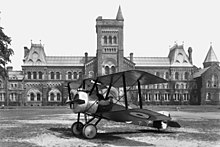loading...
Wednesday, 4 November 2015
University of Toronto

The establishing of a pioneer school had long been the craving of John Graves Simcoe, the first Lieutenant-Governor of Upper Canada. As an Oxford-taught military officer who had battled in the American Revolutionary War, Simcoe trusted a school was expected to counter the spread of republicanism from the United States. The Upper Canada Executive Committee suggested in 1798 that a school be set up inYork, the frontier capital.

On March 15, 1827, an imperial contract was formally issued by King George IV, announcing "from this time one College, with the style and benefits of a University ... for the training of youth in the standards of the Christian Religion, and for their guideline in the different branches of Science and Literature ... to proceed for ever, to be called King's College."The giving of the sanction was generally the consequence of extreme campaigning by John Strachan, the persuasive Anglican Bishop of Toronto who took office as the first president of the school. The first three-story Greek Revival school building was developed on the present site of Queen's Park.
Under Strachan's stewardship, King's College was a religious organization that firmly adjusted to the Church of England and the British pioneer world class, known as the Family Compact. Reformist government officials restricted the church's control over frontier establishments and battled to have the school secularized. In 1849, after an extensive and warmed civil argument, the recently chose mindful legislature of Upper Canada voted to rename King's College as the University of Toronto and disjoined the school's ties with the congregation. Having expected this choice, the incensed Strachan had surrendered a year before to open Trinity College as a private Anglican theological college. College was made as the nondenominational showing branch of the University of Toronto. Amid the American Civil War, the danger of Union barricade on British North America incited the formation of the University Rifle Corps, which saw fight in opposing the Fenian strikes on the Niagara fringe in 1866.

Set up in 1878, the School of Practical Science was antecedent to the Faculty of Applied Science and Engineering, which has been nicknamed Skule since its most punctual days.While the Faculty of Medicine opened in 1843, therapeutic instructing was directed by exclusive schools from 1853 until 1887, when the staff assimilated the Toronto School of Medicine. Then, the college kept on setting examinations and give restorative degrees amid that period. The college opened the Faculty of Law in 1887, and it was trailed by the Faculty of Dentistry in 1888, when the Royal College of Dental Surgeons became an associate. Ladies were admitted to the college without precedent for 1884.
A staggering flame in 1890 gutted the inside of University College and obliterated thirty-three thousand volumes from the library, yet the college restored the building and renewed its library inside of two years. Throughout the following two decades, a university framework continuously came to fruition as the college masterminded alliance with a few ministerial schools, incorporating Strachan's Trinity College in 1904. The college worked the Royal Conservatory of Music from 1896 to 1991 and the Royal Ontario Museum from 1912 to 1968; both still hold close ties with the college as free foundations. The University of Toronto Press was established in 1901 as the first academic distributed house in Canada. The Faculty of Forestry, established in 1907 with Bernhard Fernow as senior member, was the first college staff committed to backwoods science in Canada. In 1910, the Faculty of Education opened its research facility school, the University of Toronto Schools.
The First and Second World Wars reduced some college exercises as undergrad and graduate men enthusiastically enrolled. Intercollegiate athletic rivalries and the Hart House Debates were suspended, in spite of the fact that display and interfaculty amusements were still held. The David Dunlap Observatory in Richmond Hill opened in 1935, trailed by the University of Toronto Institute for Aerospace Studies in 1949. The college openedsatellite grounds in Scarborough in 1964 and in Mississauga in 1967. The college's previous associated schools at the Ontario Agricultural College and Glendon Hall turned out to be completely free of the University of Toronto and turned out to be a piece of University of Guelph in 1964 and York University in 1965, individually. Starting in the 1980s, decreases in government financing incited more thorough raising money endeavors. The University of Toronto was the first Canadian college to accumulate a money related blessing more noteworthy than C$1 billion.